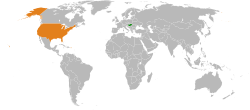
Hungary wields considerable influence in Central and Eastern Europe and is a middle power in international affairs. The foreign policy of Hungary includes commitments to international development, international law, European integration, Atlantic co-operation and co-operation with the global East. The Hungarian economy is fairly open and relies strongly on international trade.
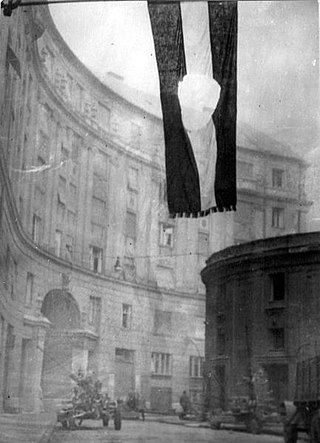
The Hungarian Revolution of 1956, also known as the Hungarian Uprising, was an attempted countrywide revolution against the government of the Hungarian People's Republic (1949–1989) and the policies caused by the government's subordination to the Soviet Union (USSR). The uprising lasted 12 days before being crushed by Soviet tanks and troops on 4 November 1956. Thousands were killed and wounded and nearly a quarter of a million Hungarians fled the country.

In political science, rollback is the strategy of forcing a change in the major policies of a state, usually by replacing its ruling regime. It contrasts with containment, which means preventing the expansion of that state; and with détente, which means developing a working relationship with that state. Most of the discussions of rollback in the scholarly literature deal with United States foreign policy toward communist countries during the Cold War. The rollback strategy was tried and was not successful in Korea in 1950 and in Cuba in 1961, but it was successful in Grenada in 1983. The United States discussed the use of rollback during the East German uprising of 1953 and the Hungarian Revolution of 1956, which were ultimately crushed by the Soviet Army, but decided against it to avoid the risk of a major war.

Ferenc Nagy was a Hungarian politician of the Smallholders Party who served as Prime Minister of Hungary from 1946 until his forced resignation in 1947. He was also a Speaker of the National Assembly of Hungary and a member of the High National Council from 1945 to 1946. Nagy was the second democratically elected prime minister of Hungary, and would be the last until 1990 not to be a Communist or fellow traveler. The subsequent Hungarian prime minister Imre Nagy was unrelated to him.

Miklós Kállay de Nagykálló was a Hungarian politician who served as Prime Minister of Hungary during World War II, from 9 March 1942 to 22 March 1944. By early 1942, Hungarian Regent Admiral Miklós Horthy was seeking to put some distance between himself and Hitler's regime. He dismissed the pro-German prime minister, László Bárdossy, and replaced him with Kállay, a moderate whom Horthy expected to loosen Hungary's ties to Germany.
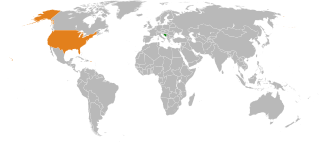
Relations between Bosnia and Herzegovina and the United States are described as very strong.

Denmark–United States relations are the bilateral relations between Denmark and the United States of America. Both countries are members of the Arctic Council, OECD, OSCE, NATO and the United Nations.

The U.S. Embassy in Austria is located in Vienna. Since 2022, the United States Ambassador to Austria is Victoria Reggie Kennedy. The Austrian Embassy in the U.S. is located in Washington, D.C. Currently, the position of the Austrian Ambassador to the United States is vacant. The current chargé d'affaires is Günther Salzmann.
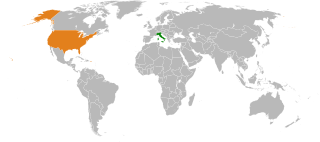
Italy and the United States enjoy warm and friendly relations. The United States has had diplomatic representation in the nation of Italy and its predecessor nation, the Kingdom of Italy, since 1840. However, in 1891 the Italian government severed diplomatic relations and briefly contemplated war against the US as a response to the unresolved case of the lynching of eleven Italians in New Orleans, Louisiana, and there was a break in relations from 1941 to 1943, while Italy and the United States were at war.

Relations between the Netherlands and the United States are described as "excellent" by the United States Department of State and "close" by the Ministry of Foreign Affairs of the Netherlands. Official relations were established in 1782 and, as the two were never at war or in serious conflict, were referred to by U.S. President Ronald Reagan in 1982 as "the longest unbroken, peaceful relationship that we have had with any other nation." The two countries have cooperated much in recent decades in anti-terrorism, anti-piracy and peacekeeping missions in the European, Middle Eastern and Central American regions. They are also the third largest and largest direct foreign investors in each other's economies.
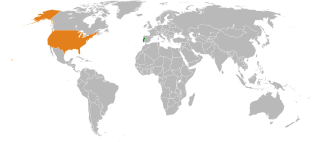
Portugal–United States relations are bilateral relations between Portugal and the United States.

Hungary–Russia relations are the bilateral foreign relations between the two countries, Hungary and Russia. During the Second World War, the Soviet army occupied Hungary, and in 1948 the Soviet Union took full control of the country. It became part of the Warsaw Pact military alliance and the Comecon economic union. Relations between the two countries were damaged in 1956 due to the Soviet military intervention in the revolution occurring in Hungary. Hungary expelled its communist government in 1989, and diplomatic relations with Russia were restored after the breakup of the USSR in 1991.
Parliamentary elections were held in Hungary on 4 November 1945. They came at a turbulent moment in the country's history: World War II had had a devastating impact; the Soviet Union was occupying it, with the Hungarian Communist Party growing in numbers; a land reform that March had radically altered the property structure; and inflation was rampant.

Canada–Hungary relations are the bilateral relations between Canada and Hungary, the importance of which centres on the history of Hungarian migration to Canada. Approximately 300,000 Canadians have Hungarian ancestry. Both nations are members of NATO, the OECD and the United Nations.

Hungary–Spain relations are the bilateral relations between Hungary and the Kingdom of Spain. Both nations are members of the Council of Europe, European Union, NATO, OECD and the United Nations.
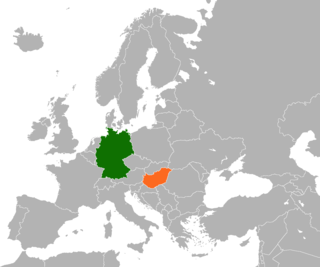
Germany and Hungary are both member states of the European Union, NATO, OECD, OSCE, Council of Europe and the World Trade Organization. Germany has an embassy in Budapest. Hungary has an embassy in Berlin, two general consulates and nine honorary consulates. The Agreement between the Federal Republic of Germany and the Republic of Hungary on 'Friendly Cooperation and Partnership in Europe' concluded on 6 February 1992 is one of the principal cornerstones of today's bilateral relations.

Indo-Hungarian relations are the bilateral ties between India and Hungary. Indian embassy is located in Budapest and that of Hungary in New Delhi.

Hungary–Kurdistan Region relations are bilateral relations between Hungary and the Kurdistan Region. Hungary is represented in Kurdistan Region through a consulate general since November 2014, while Kurdistan Region has no representation in Hungary. Relations are characterized by several high-level talks and close ties. The Kurdish President Massoud Barzani visited Hungary in 2012 and in 2015 on official visits. Moreover, Hungarian Prime Minister Viktor Orbán uttered support for the independence of Kurdistan Region from Iraq in 2015 causing concern among the Islamic Supreme Council of Iraq.

The Embassy of the United States, Budapest is the diplomatic representation of the United States in Hungary, located in Budapest in the Fifth District, at 12 Liberty Square. The embassy is housed in the building of the Hungarian Commercial Hall, which was inaugurated in 1901. Since the summer of 2022, the embassy has been led by ambassador David Pressman.
